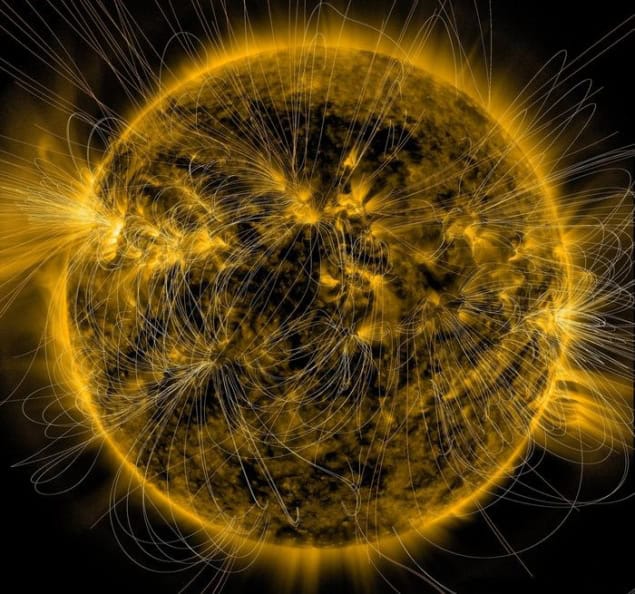
A new mathematical model indicates that the Sun’s magnetic field originates just 20,000 miles below its surface, contradicting previous theories that point to much deeper origins. The model, developed by researchers at Northwestern University in the US and the University of Edinburgh, UK, could help explain the origins of the magnetic field, and might lead to more accurate forecasts for solar storms, which can damage electronics in space and even on the ground if they are powerful enough.
The physical processes that generate the Sun’s magnetic field – the magnetic dynamo – follow a very specific pattern. Every 11 years, a propagating region of sunspots appears at a solar latitude of around 30°, and vanishes near the equator. Around the same time, longitudinal flows of gas and plasma within the Sun, known as torsional oscillations, closely follow the motion of the sunspots.
These two phenomena might be related – they might, in other words, be different manifestations of the same underlying physical process – but researchers still do not know where they come from. Recent helioseismology measurements point to a relatively shallow origin, limited to the near-surface “shear layer” located in the outer 5–10% of the star. However, that contradicts previous theoretical explanations that rely on effects arising more than 130,000 miles below the Sun’s surface.
Magnetorotational instability at the surface
Researchers led by Geoffrey Vasil at Edinburgh may have found a resolution to this conflict. According to their model, the Sun’s magnetic field does indeed stem from a near-surface effect: a unstable fluid-dynamic process known as a magnetorotational instability.
This is promising, Vasil notes, because such instabilities also occur in astrophysical systems such as black holes and young planetary systems, and we have understood them in that context since the 1950s thanks to pioneering work by the Nobel Prize-winning physicist Subrahmanyan Chandrasekhar. More exciting still, he tells Physics World, is that the new model better matches observations of the Sun, successfully reproducing physical properties seen in sub-surface torsional oscillations and magnetic field amplitudes. A final advantage is that unlike theories that invoke deeper effects, the new model describes how sunspots follow the Sun’s magnetic activity.
Several difficulties with current theories
Vasil says he first stumbled across the idea that near-surface instability could be responsible while he was a PhD student at the University of Colorado in the US. “I remember the ‘huh, that’s funny’ insight while flipping through an astrophysics textbook,” he recalls. The previous leading hypothesis, he explains, held that the Sun’s magnetic field originated at the bottom of a 130,000-mile-deep “ocean”. Two things happen down in this so-called tachocline region: “The first is that the rolling, overturning turbulence of gas and plasma stops and gives way to a calmer interior,” he says. “There is also a jump in the solar windspeed that can ‘stretch’ magnetic fields.”
While these ideas hold some appeal, they suffer from several difficulties, he adds. For one, even if the magnetic field did originate deep inside the Sun, it would still have to get to the surface. Calculations show that this would not be easy.
“Overall, it makes a lot of sense if things happen near the surface and don’t have to go anywhere,” he says. “While that’s not the only reason supporting our surface-origin hypothesis, it is a big part of it.”
A better understanding of sunspot formation
If magnetic fields do originate right below the surface, they ought to be easy to measure. Such measurements could, in turn, lead to a better understanding of sunspot formation and improved warnings of sunspot eruptions – which would help us protect sensitive electronics.

The enduring mystery of the solar corona
The researchers need much more data to continue with their investigations. “Our current work mostly concerns the shallow region near the Sun’s equator, but we know for sure that the polar regions are also extremely important, including deeper down from the poles,” says Vasil. “The difference is that we don’t have any specific physical hypotheses of what might be happening in these zones.
“We hope to obtain such data from planned satellite missions (from both NASA and the European Space Agency, ESA) to observe the solar poles in much more detail. Unfortunately, these projects have recently been put on hold, but I hope that our work will encourage others to pursue these again.”
For now, the researchers plan to concentrate on building open-source tools to help analyse the wealth of data they already have. Their present study is detailed in Nature.



